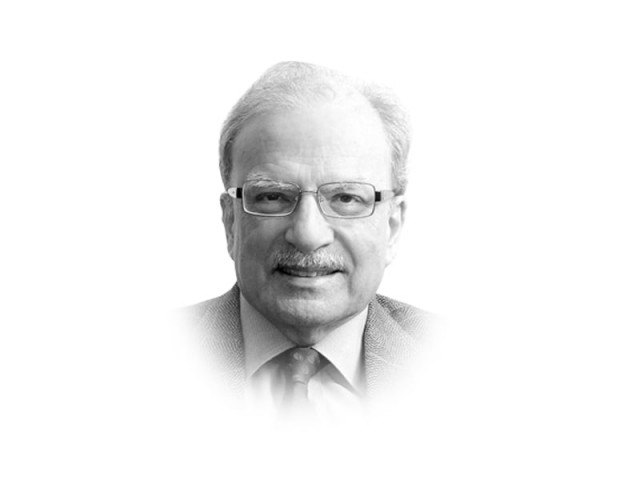Pakistan and the new Great Game
US defence strategy focusing on China, is bound to complicate the situation, add another element to Pakistan-US ties.

The deteriorating relations between the US and Pakistan, as result of a series of events in 2011, have presented the policymakers in Washington with a choice. They can work to resolve the differences and remain engaged with the country that remains critical to its long-term — not just short-term — strategic interests or, they can simply walk out of the country as was done in 1989 when Pakistan’s usefulness to the US was diminished after the Soviet Union was pushed out of Afghanistan. There is considerable temptation to adopt the latter approach. That is certainly the case in the US Congress, which has already declared its intention to reduce the amount of military assistance and economic aid promised to Pakistan.
The new US defence strategy, by focusing so much attention on China, is bound to further complicate the situation and add another element in the American-Pakistani equation. With heavy dependence on external flows to retain some dynamism in the economy and with the Americans threatening to reduce their assistance, Islamabad has already reacted by attempting to draw even closer to Beijing. This effort was only partially successful; Beijing, with its eye on Washington, was not inclined to walk into Pakistan to fully compensate for the threatened American withdrawal. But Beijing may rethink its cautious approach. If the defence strategy sends the message to Beijing that China-containment had become the main interest for the US in world affairs, the Chinese may seek to list Islamabad as its partner to counter the American moves. And if the US responds by getting even closer to India what will result is a four-power ‘Great Game’ with America and India seeking to contain China and China and Pakistan working together to limit Washington’s influence in their geographic space. This will be an unhappy development for South Asia.
What is needed instead is a deep American involvement in helping Pakistan to develop its political system and its economy to guide the ongoing revolution in the Middle East and several other Muslim countries into the right channels. Drawing a connection between the Arab Spring and Pakistan’s development as a way of helping the West’s strategic interests may, at first sight, seem a bit of a stretch. But such a link becomes apparent when the dynamic unleashed by the events in the Middle East is put in a historical perspective.
What is at issue now is the direction the Arab Spring is likely to take. The first series of elections in the Arab world — in Morocco, Tunisia and Egypt — following the street-inspired revolutions have brought parties with strong Islamic roots into prominence. In Egypt, it is already clear that the party affiliated with the Muslim Brotherhood will have the largest presence in the newly elected assembly. It has won close to one-half of the seats, while another quarter has gone to the Salafists. The revolution was brought about by disaffected youth but its consequences will not bring them into political power. “So why are so many Arabs voting for parties that seem regressive to Westerners?” asks John M Owen, a professor of politics at the University of Virginia and the author of an important book on the clash of ideas and politics. His answer: “Liberalism in the 19-century Europe and Islamism in the Arab world today, are like channels dug by one generation of activists and kept open, sometimes quietly, by future ones. When the storms of revolution arrive, whether in Europe or in the Middle East, the waters will find those channels. Islamism is winning out because it is the deepest and widest channel into which today’s Arab discontent can flow”.
But today’s revolutions are different from those that came earlier; they are taking place in full global view where those participating in them are in constant communication with those watching them. It is unlikely that the liberal forces that relieved the countries of absolutist leadership will easily give way to the dominance of political forces that may take the affected countries towards another form of control. This happened in Iran in the late 1970s. To ensure that Islamists, even if they win elections, will not dispense with liberal democratic forms, the liberal forces are looking for models in which religious parties are embedded within democratic systems.
Pakistan could become such a model if its fledgling democratic system succeeds. Pakistan, at this time, is deeply involved in containing the rise of Islamic extremism. One way to deal with it is to combine the use of force with accommodation. Those not prepared to work within the established legal framework must be dealt with firmly while those inclined to use the norms of democracy to advance their agendas must be given accommodation. Pakistan’s difficult political evolution is being watched by many in the Middle East. If it succeeds, it will be seen as an example to be replicated. However, the United States by withdrawing its support at such a critical time and forcing the new Great Game on South Asia, will unleash another dynamic that could seriously set back the Pakistani experiment. A strong anti-American sentiment would undoubtedly help the Islamic groups and inhibit the more liberal forces. In other words, Washington must look at Pakistan through the lens of the Arab Spring rather than as a player on the other side of the game to contain China.
Published in The Express Tribune, January 17th, 2012.


















COMMENTS
Comments are moderated and generally will be posted if they are on-topic and not abusive.
For more information, please see our Comments FAQ